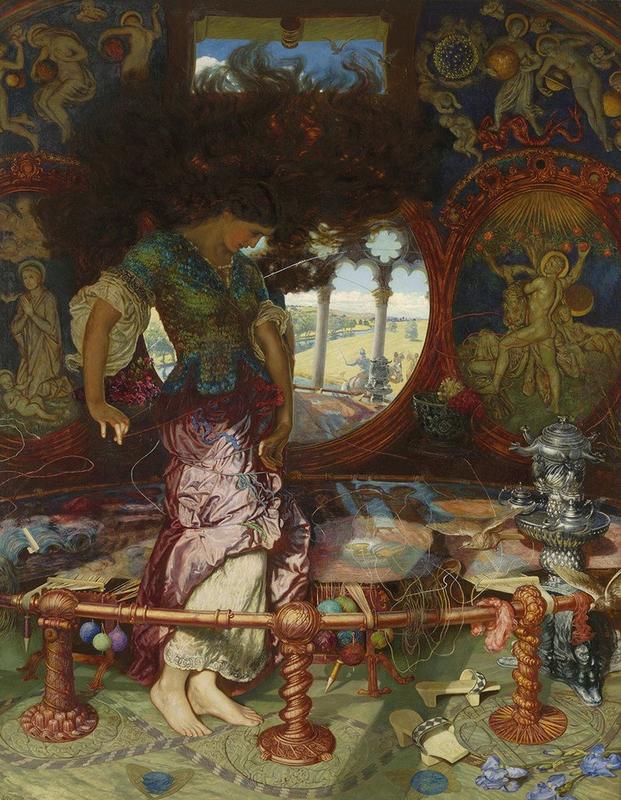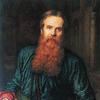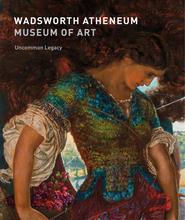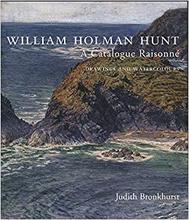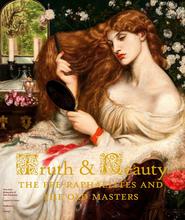More about The Lady of Shalott
- All
- Info
- Shop
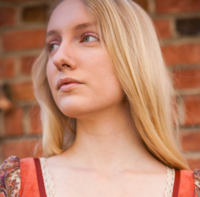
Editor
It took William Holman Hunt fifteen years to finish a painting that just happens to be about artists getting distracted from their work.
If, as a core member of the Pre-Raphaelite Brotherhood, William Holman Hunt often drew inspiration from late medieval art, it’s no surprise that he would be drawn to the medievalized works of romantic poets. While the English pictorial tradition had suffered since the Reformation, England’s literary tradition had flourished. Sir Alfred Lord Tennyson had just been named Poet Laureate of England in 1850, so he was rather topical that year when both Hunt and John Everett Millais selected subjects from his poetry to paint. While Millais painted Mariana, Hunt did a drawing of what would one day become this monumental painting.
The subject of this painting is Tennyson’s hypnotic 1832 poem “The Lady of Shalott,” a tale based on the Arthurian legend of Elaine of Astolat. In Tennyson’s poem, the mysterious Lady of Shalott is imprisoned in a tower on an island in the river that flows to Camelot. Cursed to never look or venture outside, she can only gaze into a mirror whose reflections of the outside world she is forced to weave into a tapestry web. While she industriously labors over her magic tapestry, her loneliness distracts her; “I am half-sick of shadows,” cries the Lady as a pair of lovers goes past. Eventually who should ride by but Sir Lancelot himself, and is he a library book? Because our lady wants to Check. Him. Out. She struggles with her desire to look upon the knight and ultimately decides to leave the chastity to Sir Galahad, as in the 13th stanza of the poem,
She left the web, she left the loom,
She made three paces thro' the room,
She saw the water-lily bloom,
She saw the helmet and the plume,
She look'd down to Camelot.
Out flew the web and floated wide;
The mirror crack'd from side to side;
"The curse is come upon me," cried
The Lady of Shalott.
She leaves her tower, climbs into a boat, and floats down the river to meet her doom, with only enough time to scratch her name into the boat to identify her corpse. While John William Waterhouse and others painted images of her final ride, Hunt chose to paint the narrative’s denouement--the very moment in the 13th stanza when the curse is activated, the mirror cracks and the tapestry begins to unravel. It’s made even more dramatic by her gravity-defying hair and the wildly winding skeins of wool that evoke her distraught state of mind. This work actually underwent multiple transformations before it became the painting it is today. After his initial 1850 drawing, he arrived at his definitive composition for the later paintings in 1857 for an illustration for the Moxon Tennyson, a lavish gift book that was targeted at women and to which Rossetti also contributed illustrations. Then came a small panel painting now at the Manchester Art Gallery, which he made even more grand in this final version.
While looking forward to the Symbolist and Surrealist movements, references to The Arnolfini Portrait by Jan Van Eyck, which had been purchased by the National Gallery in 1842, are abundant. Hunt himself once declared that as a young man, he “found sanction for his principles in the newly acquired Van Eyck,” those principles including faithfulness to nature, complex symbolism, and durable, brilliant colors. While the kicked off clogs and samovar are visual quotations from The Arnolfini Portrait, it was Van Eyck’s convex mirror that became an obsession with the Pre-Raphaelites, who considered it to be a sort of omniscient eye, capable of faithfully reflecting nature while being a portal into the artist’s mind and the act of re-presentation itself. Of course, the story of the Lady of Shalott hinges on a large mirror (so Hunt really hit the jackpot here!), and weavers of tapestries actually used mirrors placed behind their looms so they could monitor both sides of their work, so its presence feels fairly natural.
However one interprets this painting, it’s hard to escape a moral reading. Hunt was the most serious of the Pre-Raphaelite boys and was thoroughly convinced of the didactic role of art. Many view the poem and painting as a cautionary tale against feminine sexuality. Sequestered in her bower, her purity is in tact, but when Lancelot awakens something sexual in her, the Lady misbehaves, acts with agency, and ultimately meets her doom. Thus, a woman who strays from the home and rebels against the accepted moral code is to be cast out of society. One could see how the same person who painted The Awakening Conscience could get a little preachy.
But the complex iconography actually points to a more gender-neutral moral, one that Hunt explicitly stated. To him, the painting was about the way artistic endeavor is incompatible with life. The Lady is an artist who, distracted from her work, fails to complete her vision. In the roundels on either side of the mirror are two figures (the Virgin Mary and Hurcules) whose souls were entrusted with great tasks but who accepted their fates, and did not succumb to personal desires--examples that the Lady of Shalott should have followed. Some arcane symbolism can also be detected in the upper frieze, which depicts the three Fates with their orbs and the story of Er. Coming from the part of Plato’s “Republic” that most people skip, the story tells of a warrior named Er who dies but discovers that there is reward in the afterlife for those who fulfill their moral duty and, you know, paint their gosh-darned pictures already. Even the planets obey their duty and appear in the sky where they should, as prescribed by the Spindle of Necessity. So basically, artists need to be like planets, and the Lady of Shalott should have picked up on all this. For Hunt, this was a final statement piece all about artistic integrity in the face of worldly struggles--against celebrity, criticism, and time itself.
While hailed today as the last great Pre-Raphaelite painting, it seems it would not have found an admirer in Tennyson, who, along with his family, lambasted the Moxon illustration on which it was based. “How vilely the artists have treated my brother!” exclaimed Frederick Tennyson, while Alfred himself complained of the hair “wildly tossed as if by a tornado” and the yarn “wound round and round her like threads of a cocoon” as evidence of too much artistic license. Apparently having a moral obligation to paint does not necessarily mean one's artistic vision is valid.
Sources
- Barringer, Tim, Jason Rosenfeld and Alison Smith. Pre-Raphaelites: Victorian Art and Design. London: Tate Publishing, 2012.
- Buron, Melissa. Truth & Beauty: The Pre-Raphaelites and the Old Masters. New York: Prestel, 2018.
- Forward, Stephanie. “An Introduction to ‘The Lady of Shalott.’” Last modified May 15, 2014. https://www.bl.uk/romantics-and-victorians/articles/an-introduction-to-…
- Forward, Stephanie. “Tennyson’s Rise and Fall.” Last modified May 15, 2014. https://www.bl.uk/romantics-and-victorians/articles/tennysons-rise-and-…
- Marsh, Jan. Pre-Raphaelite Women: Images of Femininity. New York: Harmony Books, 1987.
- Smith, Alison. Reflections: Van Eyck and the Pre-Raphaelites. London: The National Gallery, 2017.
- Tennyson, Alfred, Lord. “The Lady of Shalott (1832).” Accessed July 3, 2018. https://www.poetryfoundation.org/poems/45359/the-lady-of-shalott-1832
- Treuherz, Julian. Victorian Painting. London: Thames & Hudson, 1993.

